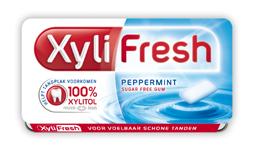Waiting room brochure Your mouth, fresh & healthy!
Waiting room brochure Your mouth, fresh & healthy!
A fresh mouth looks nice
With a healthy mouth you can eat and drink without any problems. And of course a fresh mouth looks nice. You can keep it that way with good oral care. Do you actually know what to do to keep your mouth healthy?
Get rid of that dental plaque
Avoid cavities
To keep your mouth healthy, you need to remove plaque. This white-yellow layer is difficult to see and forms on and between your teeth and on the transition to the gums. Dental plaque consists of bacteria and products of bacteria. They are in your mouth after all. Almost all our food and drinks contain sugars and starch. Sugars are added to many foods (e.g. soft drinks), but there are also naturally occurring sugars in products (e.g. fruit). The bacteria in your mouth convert sugars and starches into acids. Those acids cause cavities in your teeth.
Prevent inflamed gums
Dental plaque also causes inflamed gums. If you don't remove the plaque properly, the bacteria in the plaque will cause your gums to become inflamed. Dental plaque that is not removed can harden and calcify into tartar. New plaque easily adheres to tartar. This causes the gums to become increasingly inflamed. The inflammation can spread and affect the underlying jaw bone. Eventually, so much jaw bone can disappear that your teeth and molars become loose.
Take the dental plaque test
Did you brush well? Has all the dental plaque disappeared? Check your brushing performance with a dental plaque indicator. It is a useful tool to make dental plaque visible. After brushing your teeth, chew the tablet and spread the dye over your teeth with your tongue. Then rinse off the excess dye with a small sip of water. Do you still see red spots on your teeth? That's dental plaque. So better brush!

Helpful oral care tips
Brush your teeth twice a day
Brushing your teeth is the basis for good oral hygiene. It is a meticulous job and certainly not easy. Therefore, brush your teeth carefully and not too vigorously twice a day. A good brushing session takes two minutes. So take your time!
Also between your teeth
You cannot always clean the spaces between your teeth properly with a toothbrush alone. It does not matter whether you use a manual toothbrush or an electric toothbrush. You can't get in between with any toothbrush. Your dentist or dental hygienist may advise you to clean the spaces between your teeth once a day with brushes, dental floss or toothpicks. Ask your practitioner which aid is best for you and how to use it.
Choose a good toothbrush
Choose a soft bristle brush with a small bristle head. Replace the toothbrush every three months or sooner if the bristles begin to separate. You can also brush your teeth effectively with an electric toothbrush. This makes the correct brushing movement. This way you can better concentrate on placing the brush head in your mouth. The same applies here: a new brush head removes more dental plaque than a brush that needs to be replaced.
Use fluoride toothpaste
Fluoride makes tooth enamel stronger and less soluble in acid. Therefore, use fluoride toothpaste with 1,000 - 1,500 ppm*) fluoride twice a day (see packaging).
Eat or drink up to seven times a day
Soft drinks, fruit (juice), yogurt drinks and wine contain acids as well as sugars. You can barely taste the acid. The sugar dominates the sour taste. Acids attack your tooth enamel. This wears out your teeth. This form of wear is called dental erosion. Dental erosion is an insidious process that is not easy to reverse. It's not just about how many acidic products you eat or drink. The more often you do this and the longer you keep acidic products in your mouth, the greater the risk of dental erosion. The way you eat or drink also has an influence. Therefore, choose three main meals a day and take something in between a maximum of four times a day. This gives your teeth sufficient opportunity to recover.
Eat acidic fruit no more than twice a day and drink soft drinks and other acidic drinks in moderation. Water, coffee and regular tea without sugar are not harmful to your teeth.
Do not use acidic products one hour before brushing your teeth
The acid affects the tooth enamel. The brush and toothpaste have an abrasive effect. If you brush your teeth immediately after eating or drinking acid, you can easily brush away the tooth enamel. Then your teeth will wear out even faster.
Sugar-free chewing gum protects your teeth
Did you know that saliva protects your teeth against dental erosion? Saliva neutralizes the acids from food and drinks. When you chew gum, you activate the production of saliva. Choose a sugar-free chewing gum. Xylitol is a natural sweetener. Xylifresh chewing gum with 100% xylitol helps prevent dental plaque and is recommended by the Ivory Cross.
Visit your dentist
Go to the dentist or dental hygienist twice a year. Then your teeth will be checked properly and you will receive guidance to keep your mouth healthy.
*) = parts per million
